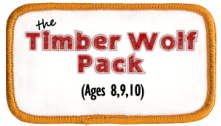TRADITIONAL SCOUTING
Something Old in a New Way!

To learn more about each section in the BPSA group, click the sections above:
Traditional Scouting uses training in small groups that allow the youth to learn teamwork as well as give them enough room for individual development. Within each BPSA Scouting Group, scouts are organized in groups called “sections” according to their age. Also, in BPSA, Scouting units are referred to as “Groups,” not “Troops” (which only applies to the Explorer section). To understand this process, the organization of a Traditional Scouting Group is like an umbrella. Each Scout Group will have under it one or more sections: either an Otter Raft, Timberwolf Pack, Explorer Troop, or Rover Crew. If you are registering a new Group, you’ll have at least one of these sections, depending on the age of the interested members.
Another important thing to remember is that all section leaders within a BPSA Scout Group must be registered as scouts themselves, and they, together with the Group Scoutmaster, will comprise the Group Council. And, since they, too, are scouts (and must be 18 years of age or older), they will also comprise your group’s Rover Crew. So all section leaders/Scoutmasters can also qualify as Rovers and are encouraged to earn their own badges as they work within their Patrols.
Every section follows a program that is appropriate to the age of the youth, but is still designed to follow the aims and methods of Traditional Scouting.
Within their age sections, the scouts are organized into smaller groups of 5 to 8, where most of their training takes place. In sections older than the Otters, each smaller group has its own youth leader as well as adult leaders (Scoutmasters/Assistant Scoutmasters) helping them with their work.
Traditional Scouting uses training in small groups that allow the youth to learn teamwork as well as give them enough room for individual development. Within each BPSA Scouting Group, scouts are organized in groups called “sections” according to their age. Also, in BPSA, Scouting units are referred to as “Groups,” not “Troops” (which only applies to the Explorer section). To understand this process, the organization of a Traditional Scouting Group is like an umbrella. Each Scout Group will have under it one or more sections: either an Otter Raft, Timberwolf Pack, Explorer Troop, or Rover Crew. If you are registering a new Group, you’ll have at least one of these sections, depending on the age of the interested members.
Another important thing to remember is that all section leaders within a BPSA Scout Group must be registered as scouts themselves, and they, together with the Group Scoutmaster, will comprise the Group Council. And, since they, too, are scouts (and must be 18 years of age or older), they will also comprise your group’s Rover Crew. So all section leaders/Scoutmasters can also qualify as Rovers and are encouraged to earn their own badges as they work within their Patrols.
Every section follows a program that is appropriate to the age of the youth, but is still designed to follow the aims and methods of Traditional Scouting.
Within their age sections, the scouts are organized into smaller groups of 5 to 8, where most of their training takes place. In sections older than the Otters, each smaller group has its own youth leader as well as adult leaders (Scoutmasters/Assistant Scoutmasters) helping them with their work.



